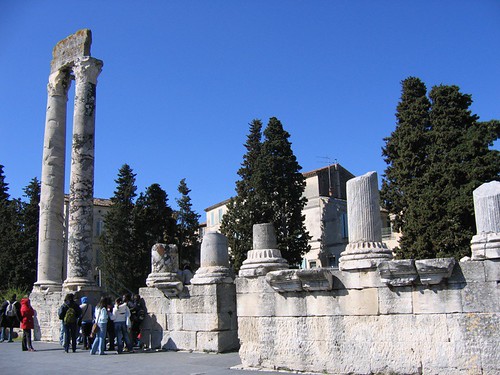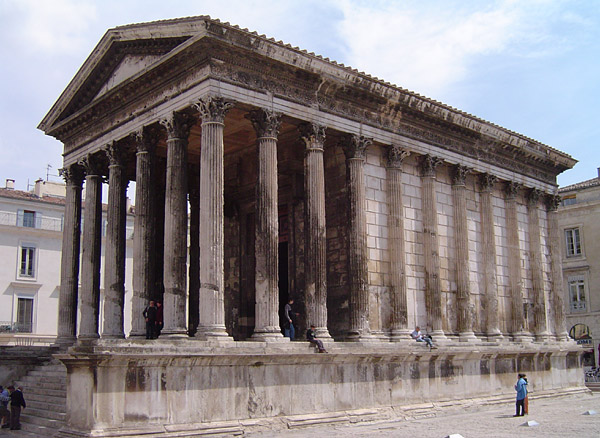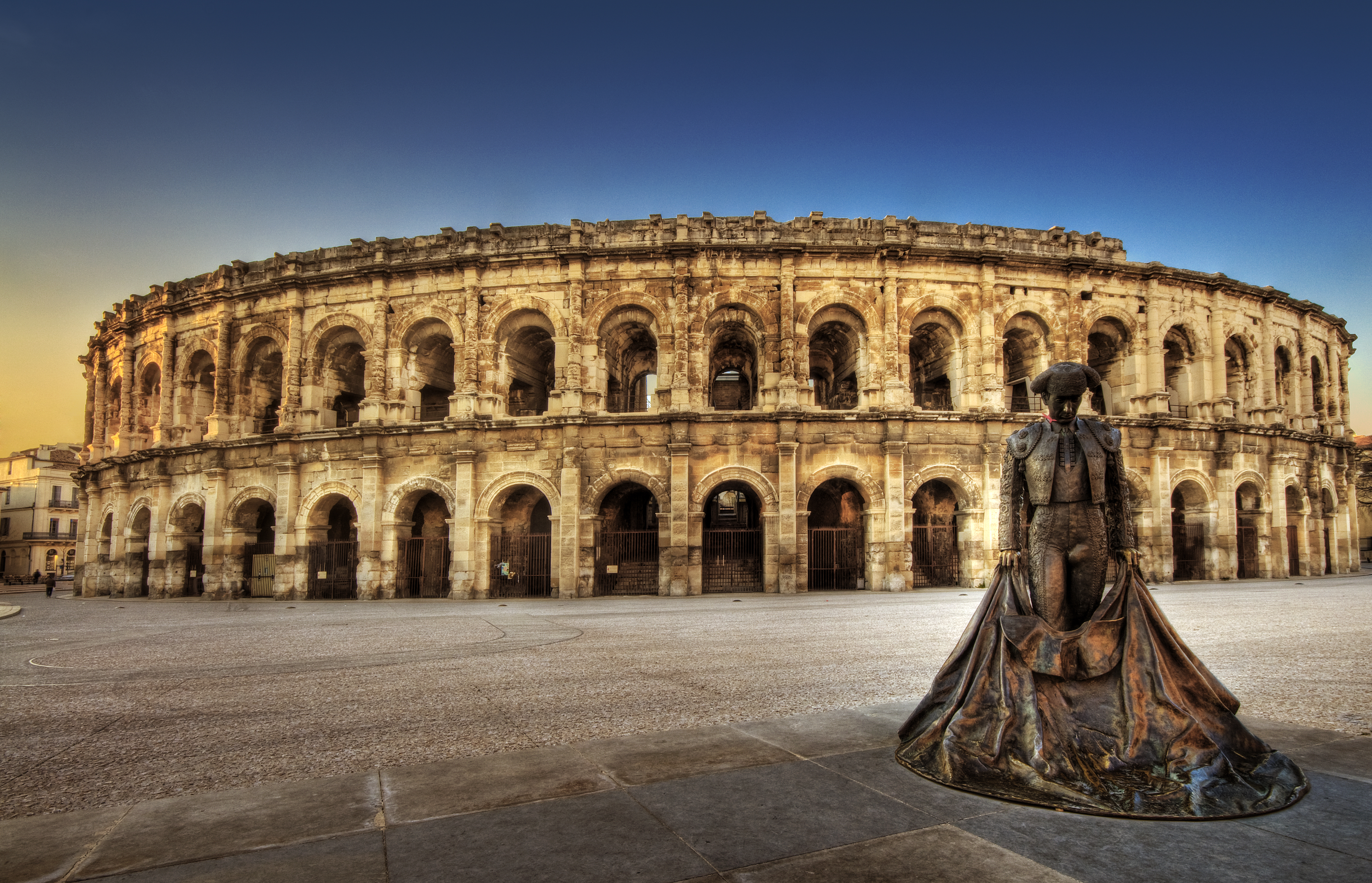AGENDA:
1. Take the 7:46 am TGV train out of Paris and arrive at Nîmes
2. Check into hotel
3. Take train to Aries
6. Tour the sights in Aries
7. Take train to Avignon
8. Tour the Popes Palace
9. Take train back to Nimes
The TGV train from Paris to Nimes
ARLES

The Main Sights in Arles
- The Roman theater
- The arena or amphitheater
- The Alyscamps (Roman necropolis)
- The Thermae of Constantine
- The cryptoporticus
- The obelisk
Cafe Terrace at Night by Vincent Van Gogh (September 1888). It depicts the warmth of a café in Arles.
Arènes d'Arles
 Arles was established by the Romans. The Romans took the town in 123 BC and expanded it into an important city, with a canal link to the Mediterranean Sea being constructed in 104 BC. However, it struggled to escape the shadow of Marseilla further along the coast.
Arles was established by the Romans. The Romans took the town in 123 BC and expanded it into an important city, with a canal link to the Mediterranean Sea being constructed in 104 BC. However, it struggled to escape the shadow of Marseilla further along the coast. Its chance came when it sided with Julius Caesar against Pompey, providing military support. Massalia backed Pompey; when Caesar emerged victorious, Massalia was stripped of its possessions, which were transferred to Arelate as a reward. The town was formally established as a colony for veterans of the Roman legion Legi VI Ferrata, which had its base there. Its full title as a colony was Colonia Iulia Paterna Arelatensium Sextanorum, "the ancestral Julian colony of Arles of the soldiers of the Sixth."
The Roman Theatre The characteristics of Roman theatres are similar to those of the earlier Greek theatres due in large part to its influence on a single Roman Consul or emperor, Gnaeus Pompeius Magnus. Much of the architectural influence on the Romans came from the Greeks, and theatre structural design was no different from other buildings. However, Roman theatres have specific differences, such as being built upon their own foundations instead of earthen works or a hillside and being completely enclosed on all sides. Roman theatres derive their basic design from the Theatre of Pompey, the first permanent Roman theatre.
The characteristics of Roman theatres are similar to those of the earlier Greek theatres due in large part to its influence on a single Roman Consul or emperor, Gnaeus Pompeius Magnus. Much of the architectural influence on the Romans came from the Greeks, and theatre structural design was no different from other buildings. However, Roman theatres have specific differences, such as being built upon their own foundations instead of earthen works or a hillside and being completely enclosed on all sides. Roman theatres derive their basic design from the Theatre of Pompey, the first permanent Roman theatre.The Oblisk
 The obelisk was first erected under the Roman emperor Constantine II in the center of the spina of the Roman circus of Arles. After the circus was abandoned in the 6th century, the obelisk fell down and was broken in two parts. It was rediscovered in 1389. Its re-erection in its current location was completed on March 26, 1676, on top of a pedestal designed by Arlesian architect Jacques Peytret. A fountain was added at its base during the 19th century, together with bronze sculptures by Antoine Laurent Dantan.
The obelisk was first erected under the Roman emperor Constantine II in the center of the spina of the Roman circus of Arles. After the circus was abandoned in the 6th century, the obelisk fell down and was broken in two parts. It was rediscovered in 1389. Its re-erection in its current location was completed on March 26, 1676, on top of a pedestal designed by Arlesian architect Jacques Peytret. A fountain was added at its base during the 19th century, together with bronze sculptures by Antoine Laurent Dantan.AVIGNON
Popes' Palace (Palais des Papes)
 Avignon became the residence of the Popes in 1309, when the Gascon Bertrand de Goth, as Pope Clement V, unwilling to face the violent chaos of Rome after his election (1305), moved the Papal Curia to Avignon, a period known as the Avignon Papacy. Clement lived as a guest in the Dominican monastery at Avignon, and his successor Pople John XXII set up a magnificent establishment there, but the reconstruction of the old bishops' palace was begun in earnest by Pope Benedict XII (1334-42) and continued by his successors to 1364. The site, on a natural rocky outcrop at the northern edge of Avignon, overlooking the river Rhone, was that of the old episcopal palace of the bishops of Avignon. The Palais was built in two principal phases with two distinct segments, known as the Palais Vieux (Old Palace) and Palais Neuf (New Palace). By the time of its completion, it occupied an area of 11,000 m² (2.6 acres). The building was enormously expensive, consuming much of the papacy's income during its construction.
Avignon became the residence of the Popes in 1309, when the Gascon Bertrand de Goth, as Pope Clement V, unwilling to face the violent chaos of Rome after his election (1305), moved the Papal Curia to Avignon, a period known as the Avignon Papacy. Clement lived as a guest in the Dominican monastery at Avignon, and his successor Pople John XXII set up a magnificent establishment there, but the reconstruction of the old bishops' palace was begun in earnest by Pope Benedict XII (1334-42) and continued by his successors to 1364. The site, on a natural rocky outcrop at the northern edge of Avignon, overlooking the river Rhone, was that of the old episcopal palace of the bishops of Avignon. The Palais was built in two principal phases with two distinct segments, known as the Palais Vieux (Old Palace) and Palais Neuf (New Palace). By the time of its completion, it occupied an area of 11,000 m² (2.6 acres). The building was enormously expensive, consuming much of the papacy's income during its construction.NIMES
The Main Sights in Nimes
Nîmes may have been one of the richest and finest Roman cities of Gaul.
- The Maison Carrée
- The Arena of Nîmes
Maison Carrée

The Maison Carrée is an ancient building in Nimes; it is one of the best preserved temples to be found anywhere in the territory of the former Roman Empire. It was built c. 16 BC, and reconstructed in the following years, by Marcus Vipsanius Agrippa, who was also the original patron of the Pantheon in Rome, and was dedicated or rededicated c. 2-4/5 AD to his two sons, Gaius Julius Caesar and Lucius Caesar, adopted heirs of Augustus who both died young. The inscription dedicating the temple to Gaius and Lucius was removed in medieval times. However, a local scholar, Jean-François Séguier, was able to reconstruct the inscription in 1758 from the order and number of the holes in the portico's facade, to which the bronze letters had been affixed by projecting tines. According to Séguier's reconstruction, the text of the dedication read (in translation): "To Gaius Caesar, son of Augustus, Consul; to Lucius Caesar, son of Augustus, Consul designate; to the princes of youth." The temple owes its preservation to the fact that it was rededicated as a Christian church in the fourth century, saving it from the widespread destruction of temples that followed the adoption of Christianity as Rome's official state religion. It subsequently became a meeting hall for the city's consuls, a canon's house, a stable for government-owned horses during the French Revolution and a storehouse for the city archives. It became a museum after 1823. Its French name derives from the archaic term carré long, literally meaning a "long square", or rectangle - a reference to the building's shape.
The Arena of Nîmes
 The elliptical Roman amphitheatre, of the first or second century AD, is the best-preserved Roman arena in France. It was filled with medieval housing, when its walls served as ramparts, but they were cleared under Napoleon. It is still used today as a bull fighting and concert arena.
The elliptical Roman amphitheatre, of the first or second century AD, is the best-preserved Roman arena in France. It was filled with medieval housing, when its walls served as ramparts, but they were cleared under Napoleon. It is still used today as a bull fighting and concert arena.HOTEL:
Hotel de Provence
